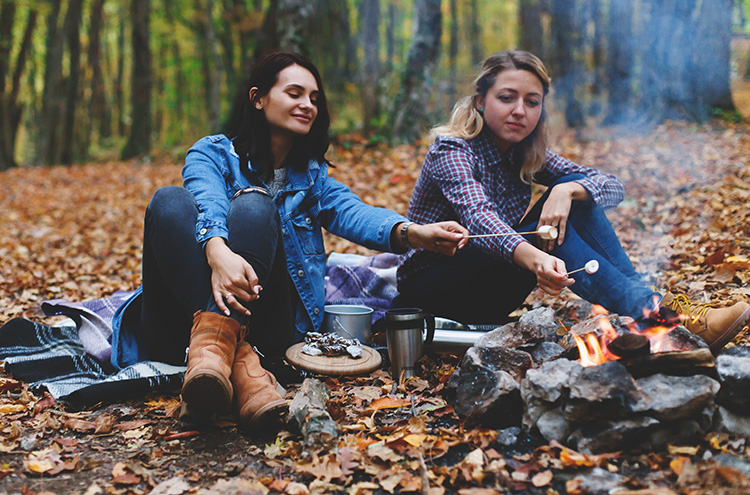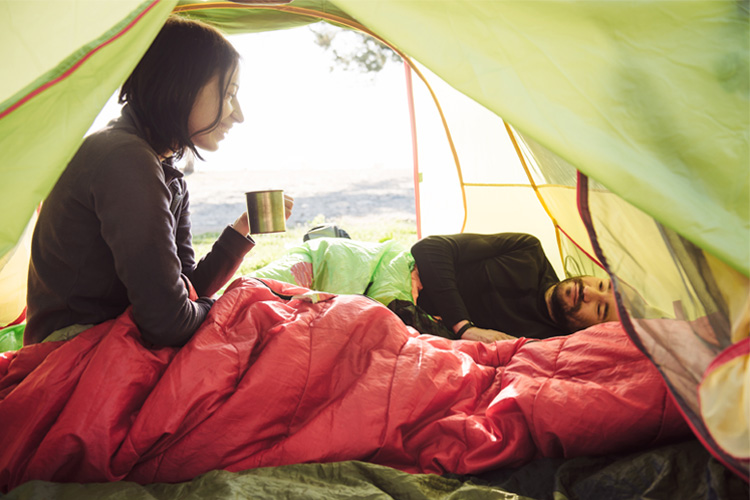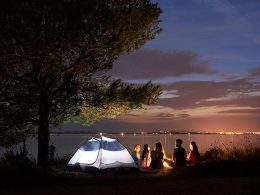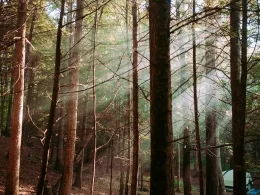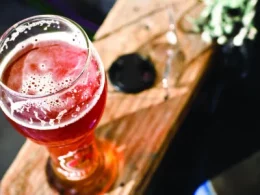By
Vin T. Sparano

Vin T. Sparano, as excerpted from Complete Guide to Camping and Wilderness Survival
1. CAMPFIRES
To start a campfire, clear a site—always on rock or dirt—by removing all ground debris for at least 3 feet on all sides. This prevents any combustible material such as rubbish and underground roots from igniting and causing a possible forest fire. When using the top of a ledge for your fire, beware of small cracks through which hot coals might tumble into flammable material.
A good fire for cooking, lighting, or heat starts with tinder, thin sticks of kindling, and medium-size sticks of firewood. Stack them loosely or in pyramid fashion in that order. Then stand on the upwind side and light the tinder from there. This directs the flame upward and into the mass of tinder. Lighting from the downwind side leaves you little opportunity to direct the flame.
Once the tinder is well ignited, blow on it or fan the fire gently with your hat. The tinder will light the slim sticks, which in turn will set the medium-size sticks ablaze. Tinder, which forms the bottom layer of the fire, is any small-size fuel that ignites readily. Any scrap of dry paper will do, especially waxed paper and the like.
There are also wood sources of tinder. Birch bark that is stripped and wadded loosely and dry cedar bark both perform well. Sagebrush bark, dead evergreen twigs still on the tree with brown needles intact, and dry, dead grass or weeds that are crushed into a ball are also effective. Pitch is a primary burning agent that is found in the decayed trunks and upturned roots of woods such as spruce, pine, and fir. It also works efficiently as tinder when sliced up with the wood still attached. To tell if a wood contains pitch, alert yourself to the resinous odor and weighty heft of the wood. Even heavy rains don’t change the quality of pitch slabs as excellent tinder.
If you are handy with a knife and adept at whittling, you can make fuzz sticks (also known as fire sticks). Shave lengthy splinters from almost any dry, soft stick, leaving as many splinters attached as possible. When you have what resembles a tiny pine tree, thrust it upright into the ground and place some tinder around it. Set a match to the lower slivers, and you have a fine fire starter.
You can squirt a little kerosene, stove gasoline, or lighter fluid on the kindling as an alternative to gathering tinder. Be sure, however, to use these liquid fuels prior to striking your match to prevent an explosion. You can also use commercial fire starters, which are available as fibrous fire sticks, tablets and tube compounds. For those who want to save a few pennies, you can make your own fire starters by soaking 100 percent cotton balls with Vaseline. About 10 to 20 of these balls can be crammed into a waterproof match case or a small plastic container. Kindling, which consists of thin, dry sticks, is ordinarily placed loosely in a tepee shape above the tinder or crisscrossed on top of it.
The basic firewood is not added until both tinder and kindling are in place. This wood is necessarily heavier than the kindling, usually longer, and from 3 to 4 inches, or possibly even 6 inches, in thickness. Small logs or thick branches are prime sources of this firewood, which catches from the combustible material beneath to provide a strong and stable fire.
Woods vary in burning qualities. They catch fire primarily in relation to their dryness, cut size, and resin content. They give heat and good cooking coals primarily in relation to their density—the denser the wood, the more mass available for combustion.
Any dry (seasoned) wood will be good kindling if cut to finger thickness. Wood of conifers tends to catch fire more easily than that of deciduous trees because their high amounts of resin ignite at lower temperatures than the gases generated from wood fibers alone. But conifers tend to be smokier, and their resin pockets cause more popping and sparks.
If you are forced to burn unseasoned wood, as in a survival predicament, ash is one of the best because of its low moisture content “on the stump.” For cooking, if very dry, the densest deciduous woods are best. These include oak, hickory, locust, beech, birch, ash, and hawthorn. Yet in parts of western states, you may find that conifers are the only woods available. In northwestern Canada and Alaska, birch and alder are about the only abundant, dense deciduous woods.
Oak and hickory rate as good wood, but remember that these hardwoods will quickly take the edge off an ax or saw—something you may want to keep in mind if you’re on an extended trip. And if sparks and smoke bother you, avoid pine and spruce, tamarack, basswood, and chestnut.

